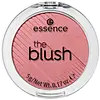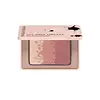What's inside
What's inside
 Key Ingredients
Key Ingredients

 Benefits
Benefits

 Concerns
Concerns

 Ingredients Side-by-side
Ingredients Side-by-side

Mica
Cosmetic ColorantPentaerythrityl Tetraisostearate
EmollientHydrogenated Vegetable Oil
EmollientCI 77891
Cosmetic ColorantOctyldodecyl Stearoyl Stearate
EmollientCI 77491
Cosmetic ColorantAluminum Starch Octenylsuccinate
AbsorbentSilica
AbrasiveCI 77499
Cosmetic ColorantHydrogenated Polyisobutene
EmollientCaprylyl Glycol
EmollientEthylhexylglycerin
Skin ConditioningCaprylic/Capric Triglyceride
MaskingAluminum Hydroxide
EmollientCI 15850
Cosmetic ColorantLauroyl Lysine
Skin ConditioningEthylene/Propylene/Styrene Copolymer
Pentaerythrityl Tetra-Di-T-Butyl Hydroxyhydrocinnamate
AntioxidantSorbitan Tristearate
EmulsifyingButylene/Ethylene/Styrene Copolymer
Tocopherol
AntioxidantCI 77492
Cosmetic ColorantCI 77007
Cosmetic ColorantKaolin
AbrasiveTalc
AbrasiveAlumina
AbrasiveSynthetic Fluorphlogopite
Diisostearyl Malate
EmollientHydrogenated Castor Oil Hydroxystearate
Skin ConditioningTin Oxide
AbrasiveSoybean Glycerides
EmollientButyrospermum Parkii Butter Unsaponifiables
Skin ConditioningZinc Stearate
Cosmetic ColorantAscorbyl Palmitate
AntioxidantMica, Pentaerythrityl Tetraisostearate, Hydrogenated Vegetable Oil, CI 77891, Octyldodecyl Stearoyl Stearate, CI 77491, Aluminum Starch Octenylsuccinate, Silica, CI 77499, Hydrogenated Polyisobutene, Caprylyl Glycol, Ethylhexylglycerin, Caprylic/Capric Triglyceride, Aluminum Hydroxide, CI 15850, Lauroyl Lysine, Ethylene/Propylene/Styrene Copolymer, Pentaerythrityl Tetra-Di-T-Butyl Hydroxyhydrocinnamate, Sorbitan Tristearate, Butylene/Ethylene/Styrene Copolymer, Tocopherol, CI 77492, CI 77007, Kaolin, Talc, Alumina, Synthetic Fluorphlogopite, Diisostearyl Malate, Hydrogenated Castor Oil Hydroxystearate, Tin Oxide, Soybean Glycerides, Butyrospermum Parkii Butter Unsaponifiables, Zinc Stearate, Ascorbyl Palmitate
Ingredients Explained
These ingredients are found in both products.
Ingredients higher up in an ingredient list are typically present in a larger amount.
Aluminum Hydroxide is a form of aluminum. It can be naturally found in nature as the mineral gibbsite. In cosmetics, Aluminum Hydroxide is used as a colorant, pH adjuster, and absorbent.
As a colorant, Aluminum Hydroxide may add opacity, or reduce the transparency. Aluminum hydroxide is contains both basic and acidic properties.
According to manufacturers, this ingredient is an emollient and humectant. This means it helps hydrate the skin.
In medicine, this ingredient is used to help relieve heartburn and help heal ulcers.
There is currently no credible scientific evidence linking aluminum hydroxide in cosmetics to increased cancer risk.
Major health organizations allow the use of aluminum hydroxide in personal care products and have not flagged it as a carcinogenic risk at typical usage levels.
Learn more about Aluminum HydroxideAluminum Starch Octenylsuccinate is a synthetic powder used as an absorbent, thickener, and anti-caking agent.
As an absorbent, it is great at mattifying skin by soaking up the oil. This is why you'll find it in a range of products from makeup to moisturizers.
This ingredient is considered a modified starch. Starch can also be found naturally in plants.
One study from 1991 found that 5% of this ingredient enhanced titanium dioxide SPF by as much as 40%. The study found 1% titanium dioxide had a 5.6 SPF and adding 5% of aluminum starch octenylsuccinate boosted it to an SPF of 8.1
Although “aluminum” in an ingredient name can raise red flags for some consumers, the form and usage context matter significantly. For typical topical applications, there is no substantial evidence of health risks - such as cancer, neurotoxicity, or systemic “aluminum overload.”
Learn more about Aluminum Starch OctenylsuccinateCi 15850 is the pigment color red. It is an azo dye and created synthetically.
Azo dyes need to be thoroughly purified before use. This allows them to be more stable and longer-lasting.
This ingredient is common in foundations, lipsticks, and blushes. This color is described as brown/orangey red.
It has many secondary names such as Red 6 and Red 7. According to a manufacturer, Red 6 usually contains aluminum.
Learn more about CI 15850Ci 77491 is also hydrated iron III oxide. It's sole purpose is to give a red/pink hue to products.
Iron III oxides are classified as inorganic chemicals for coloring.
Synthetically created Ci 77491 is considered safer than those naturally found. This is because the synthetically created version may contain less impurities. Iron oxides are generally non-toxic and non-allergenic.
Learn more about CI 77491Ci 77499 is also hydrated iron III oxide. It is created from mixing red and black iron oxides. This helps give shades of darkness to a product.
Iron III oxides are classified as inorganic chemicals for coloring.
Ethylhexylglycerin (we can't pronounce this either) is commonly used as a preservative and skin softener. It is derived from glyceryl.
You might see Ethylhexylglycerin often paired with other preservatives such as phenoxyethanol. Ethylhexylglycerin has been found to increase the effectiveness of these other preservatives.
Mica is a naturally occurring mineral used to add shimmer and color in cosmetics. It can also help improve the texture of a product or give it an opaque, white/silver color.
Serecite is the name for very fine but ragged grains of mica.
This ingredient is often coated with metal oxides like titanium dioxide. Trace amounts of heavy metals may be found in mica, but these metals are not harmful in our personal products.
Mica has been used since prehistoric times throughout the world. Ancient Egyptian, Indian, Greek, Roman, Aztec, and Chinese civilizations have used mica.
Learn more about MicaTalc is a clay mineral. It helps absorb moisture and improve the texture of products. Like other types of clay, Talc can have a slight exfoliating effect on skin. Talc can be added to increase the volume of products.
Some Baby powders are made by combining talc with corn starch. The word "talc" comes from Latin and originates from Arabic. Talc is a mineral commonly found throughout the world.
If you have any concerns about using talc, we recommend checking out the FDA's official page.
Learn more about Talc